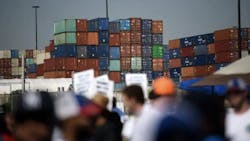“Tentative agreement” reached in landmark dock worker’s strike
After a three-day strike that crippled East Coast and Gulf ports from Maine to Texas, U.S. dock workers are returning to their stations with a 62% pay increase.
The International Longshoremen’s Association (ILA), a union encompassing 50,000 contracted members of the United States Maritime Alliance (USMX), a management group representing port authorities, terminal operators, and shipping lines, greenlit the strike on Tuesday following an impasse in negotiations. In the organization’s first walkout strike since 1977, over 45,000 workers ceased operations at 36 ports nationwide. This all but promised an economic crisis just five weeks before the upcoming presidential election in November.
Following pressure from the White House on both sides, the ILA and USMX negotiated an uncertain truce. While specifics were not disclosed, an extension of the Master Contract to January 15, 2025, and a wage increase amounting to 62% over the course of six years are on the table, according to the Wall Street Journal. The ILA referenced a “return to the bargaining table to negotiate all other outstanding issues” in an official statement that USMX later mirrored.
“I want to thank the union workers, the carriers, and the port operators for acting patriotically to reopen our ports and ensure the availability of critical supplies for Hurricane Helene recovery and rebuilding,” President Joe Biden said in a statement. “Collective bargaining works, and it is critical to building a stronger economy from the middle out and the bottom up.”
“This is about fairness—and our economy works best when workers share in record profits,” said Vice President and Democratic Presidential Candidate Kamala Harris. “Dockworkers deserve a fair share for their hard work getting essential goods out to communities across America.”
Republican Presidential Candidate Donald Trump placed the blame on Biden’s shoulders, remarking on Tuesday that he “should have worked out a deal.”
The Biden administration’s push to resolve negotiations quickly in the weeks leading up to the November 5th election reflects fears that a strike of this magnitude would negatively impact the economy. White House officials calculated that the slowing of commerce so close to the election would be felt in a consumer’s day-to-day, a feeling that would remain in mind when heading to the polls on election day. Other analysts taking stock of the situation also expected severe challenges.
Chemical Processing, a sister publication of SecurityInfoWatch, expected disruptions to the movement of raw materials, chemicals, and finished products that would have caused production delays, amounting to tens of billions of dollars in damages. Diversions to West Coast ports limited some supply chain congestion, though they were nearly at capacity at the three-day mark. The acceleration of goods through ports in the days preceding the strike also softened the blow. However, estimations by Oxford Economics still projected weekly $4.5-to $7.5-billion-dollar dents in the U.S. gross domestic product.
Critics of the strike’s swift resolution consider the agreement an overreaction. Capital Economics called analysts' fears “overdone." Patrick L. Anderson, Chief Executive of the Anderson Economic Group, said that he couldn’t recall a strike that had “...so little effect on the economy, led to such a short strike, and resulted in such a huge increase in earnings for workers who are already making over $100,000 a year.”
Even still, it will take some days for operations to return to normal. The Port of New York and New Jersey and the Port of Virginia will remain closed to trucks on Friday as they recuperate. Though the discussion is ongoing, dock workers return to their posts and resume operations as quickly as possible.
In the meantime, rank-and-file ILA members still need to ratify the agreement. Should the deal be rejected, the door is open for another costly strike.

